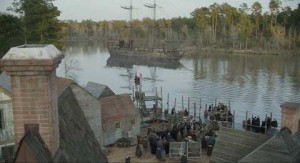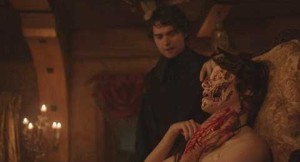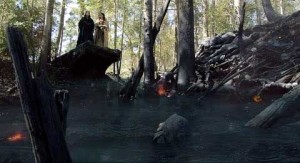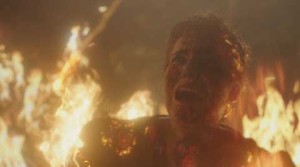
Burbank-based FuseFX is hard at work on visual effects for the 13-episode second season of Salem, a drama about witches in colonial Massachusetts that made its debut last year as WGN America‘s first original series. The studio’s team of visual effects artists are helping to conjure a 17th century world riven with black magic, intrigue and strife. The series is produced by Fox 21 Television Studios.
“On Salem, we get to do a lot of different types of effects,” said Jason Piccioni, senior VFX supervisor at FuseFX. “Right now, we’re creating a tar-like river of ooze that plays heavily in several episodes. It involves a CG fluid simulation that bubbles and burps fire. We also do a lot of blood and gore, CG ships and set extensions. It’s fun.”
A single episode of Salem can include from two dozen to more than 100 VFX shots, all of which need to be delivered within a two-week post schedule. Maintaining that pace requires a skilled, flexible crew and careful planning. Piccioni, on-set supervisor Glenn Neufeld, VFX producer Jason Spratt and other senior members of the team spend time in pre-production with Salem executive producer Brannon Braga and co-producer Skip Schoolnik scrutinizing scripts to identify visual effects needs and discussing artistic considerations. From there, the FuseFX supervisors determine personnel requirements and sketch out a workflow.
 For the show’s first season, all of the effects work was completed at FuseFX’s Burbank facility, but for season two, a portion of the work is being handled through the company’s recently launched satellite office in Vancouver. Geographical separation does not present a hurdle, as high-speed data connections and a seasoned team of supervisors allow the two groups of artists to function as though they are working in the same space.
For the show’s first season, all of the effects work was completed at FuseFX’s Burbank facility, but for season two, a portion of the work is being handled through the company’s recently launched satellite office in Vancouver. Geographical separation does not present a hurdle, as high-speed data connections and a seasoned team of supervisors allow the two groups of artists to function as though they are working in the same space.
“The VFX are very well-planned,” said Spratt, “but plans can change and the effects for this show are often complex. A single shot could have multiple plates — greenscreen, background and so forth — and there may be other small elements shot by production. Then, there are the VFX components — CG, matte paintings, compositing — and all of the pieces have to go together. And that’s just one shot. Multiply that by 20 or 100 and media management becomes a challenge.”
The effects produced by FuseFX for the show fall roughly into two categories: historical/environmental embellishments, including set extensions, matte paintings and CG ships used to establish time and place, and magical elements that support witchcraft and other supernatural emanations.
 CG artists spend considerable time searching through historical archives to find sources for architecture, natural environments, naval vessels and similar elements. “We look for real-world references in photographs, video, books and movies,” said CG supervisor Michael Kirylo. “We use those sources to develop a game plan. We rough things out and refine from there.”
CG artists spend considerable time searching through historical archives to find sources for architecture, natural environments, naval vessels and similar elements. “We look for real-world references in photographs, video, books and movies,” said CG supervisor Michael Kirylo. “We use those sources to develop a game plan. We rough things out and refine from there.”
Among supernatural effects certain types of elements prevail. The battles that rage between factions of witches call for plenty of blood and gore. CG effects are also needed to enhance practical makeup for facial and body deformities.
Fire is another recurring theme. An early episode from season two features a particularly grizzly conflagration as several witches are set ablaze in their sleep. For that sequence, the FuseFX team created CG flames to supplement practical fire shot on set. “We had to match the movement of the girls as they writhed in pain,” explained Kirylo. “We had 3D geometry of the actors, gathered on the set by Neufeld, and that allowed us to match their movement frame by frame. We ran various fire simulations over that geometry, rendered it out and composited it over the live action.”
 Getting CG fire to blend convincingly with practical fire is not easy, noted compositing supervisor Tommy Tran, adding that it typically takes several iterations to achieve seamless integration. However, when it works well, the results can be amazing. Tran pointed to a portion of the same witch burning sequence where compositors made it appear as though an actress is being burned alive.
Getting CG fire to blend convincingly with practical fire is not easy, noted compositing supervisor Tommy Tran, adding that it typically takes several iterations to achieve seamless integration. However, when it works well, the results can be amazing. Tran pointed to a portion of the same witch burning sequence where compositors made it appear as though an actress is being burned alive.
“The actress was positioned far from the practical flames but she needed to appear to char and burn,” he recalled. “We motion tracked her body and applied scars and oil. We started to char her clothing and then proceeded to her body and face. By the end, she looked like she was completely on fire. It looked really good!”
Spratt said the whole team enjoys tackling the creative and technical challenges presented by the show. “Salem is fantastic,” he said. “Brannon Braga is a great showrunner. He is very accessible to us and clear in his expectations. We do what he asks for and it’s working really well.”





